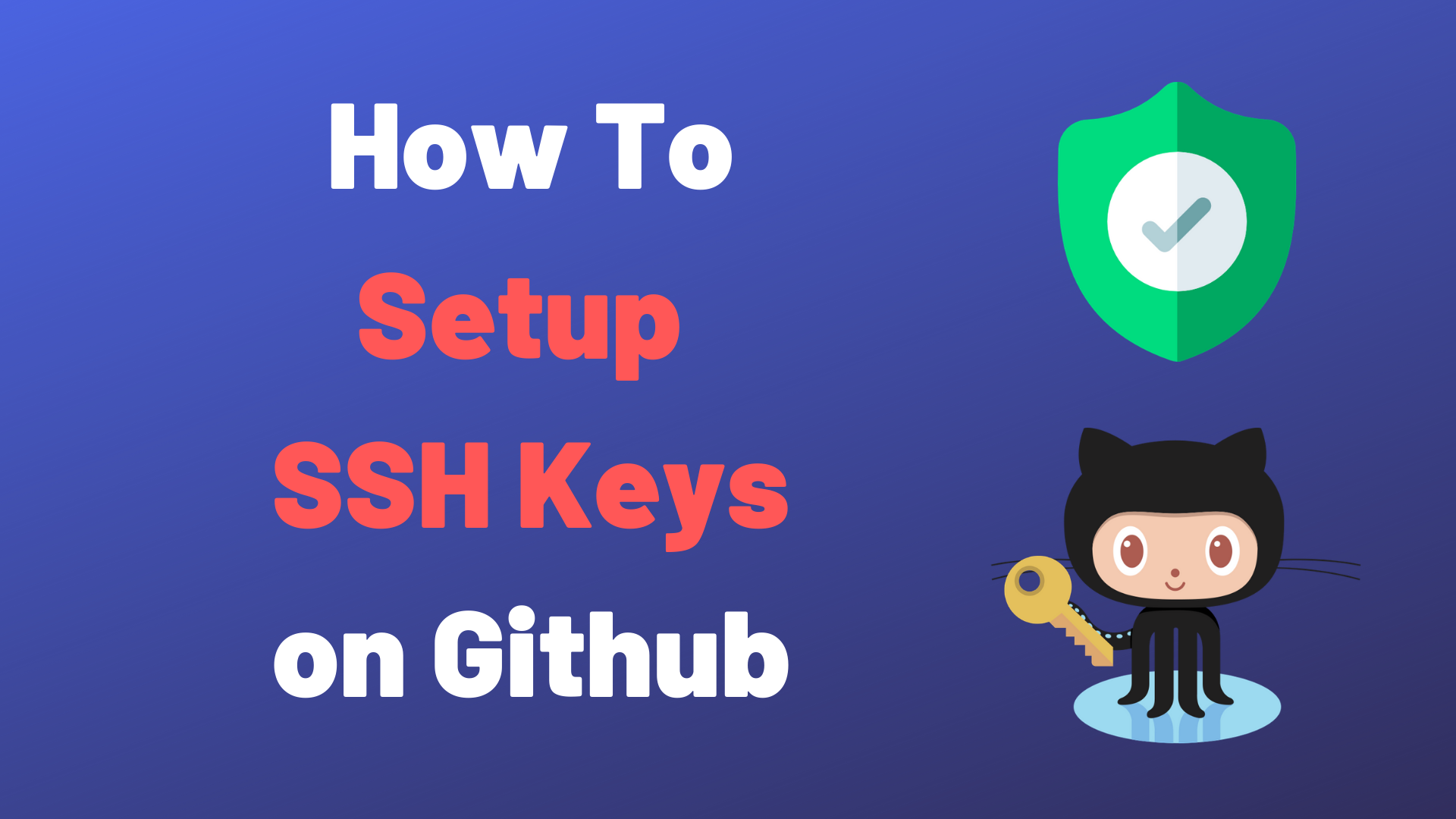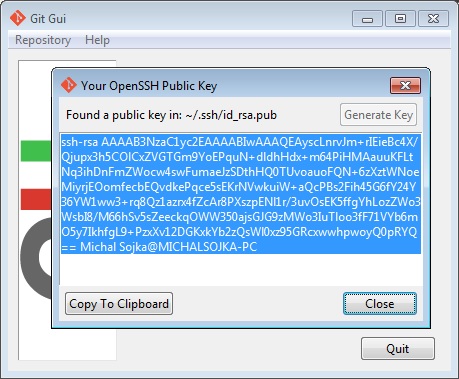Github Generate Ssh Keys Windows
- If you don't have an existing public and private key pair, or don't wish to use any that are available to connect to GitHub, then generate a new SSH key. If you see an existing public and private key pair listed (for example idrsa.pub and idrsa) that you would like to use to connect to GitHub, you can add your SSH key to the ssh-agent.
- May 13, 2016 I show you how to generate SSH keys and add them to Github so you no longer have to enter you password each time you push. Creating and Using SSH RSA Tokens on Windows 10 - Duration: 14:53.
| title | description | services | documentationcenter | author | manager | editor | tags | ms.assetid | ms.service | ms.workload | ms.tgt_pltfrm | ms.topic | ms.date | ms.author |
|---|---|---|---|---|---|---|---|---|---|---|---|---|---|---|
Learn how to generate and use SSH keys on a Windows computer to connect to a Linux virtual machine on Azure. | gwallace | azure-service-management,azure-resource-manager | virtual-machines-linux | vm-linux | 11/26/2018 |
This article describes ways to generate and use secure shell (SSH) keys on a Windows computer to create and connect to a Linux virtual machine (VM) in Azure. To use SSH keys from a Linux or macOS client, see the quick or detailed guidance.
[!INCLUDE virtual-machines-common-ssh-overview]
Oct 22, 2019 A better solution would be to share the same set of SSH keys between Windows and WSL so that you have one set of keys for one machine. Setup SSH on Windows first. My recommendation is that you set up SSH on the Windows side first. Follow the instructions over on Github’s documentation to do this. It will walk you through generating the key.
[!INCLUDE virtual-machines-common-ssh-support]
Git Windows Generate Ssh Key
Windows packages and SSH clients
You connect to and manage Linux VMs in Azure using an SSH client. Computers running Linux or macOS usually have a suite of SSH commands to generate and manage SSH keys and to make SSH connections.
Windows computers do not always have comparable SSH commands installed. Recent versions of Windows 10 provide OpenSSH client commands to create and manage SSH keys and make SSH connections from a command prompt. Recent Windows 10 versions also include the Windows Subsystem for Linux to run and access utilities such as an SSH client natively within a Bash shell.

Other common Windows SSH clients you can install locally are included in the following packages:
You can also use the SSH utilities available in Bash in the Azure Cloud Shell.
- Access Cloud Shell in your web browser at https://shell.azure.com or in the Azure portal.
- Access Cloud Shell as a terminal from within Visual Studio Code by installing the Azure Account extension.
Create an SSH key pair
The following sections describe two options to create an SSH key pair on Windows. You can use a shell command (ssh-keygen) or a GUI tool (PuTTYgen). Also note, when using Powershell to create a key, upload the public key as ssh.com(SECSH) format. When using CLI, convert the key into OpenSSH format prior to uploading.
Create SSH keys with ssh-keygen
If you run a command shell on Windows that supports SSH client tools (or you use Azure Cloud Shell), create an SSH key pair using the ssh-keygen command. Type the following command, and answer the prompts. If an SSH key pair exists in the chosen location, those files are overwritten.
For more background and information, see the quick or detailed steps to create SSH keys using ssh-keygen.
Create SSH keys with PuTTYgen
If you prefer to use a GUI-based tool to create SSH keys, you can use the PuTTYgen key generator, included with the PuTTY download package.
To create an SSH RSA key pair with PuTTYgen:

Start PuTTYgen.
Click Generate. By default PuTTYgen generates a 2048-bit SSH-2 RSA key.
Move the mouse around in the blank area to provide randomness for the key.
Ssh generate public key from private. Nov 10, 2011 How to Generate A Public/Private SSH Key Linux 1. Open a terminal. In the next screen, you should see a prompt, asking you for the location to save the key. Next, you will be prompted to enter passphrase. Your public and private SSH key should now be generated.
After the public key is generated, optionally enter and confirm a passphrase. You will be prompted for the passphrase when you authenticate to the VM with your private SSH key. Without a passphrase, if someone obtains your private key, they can sign in to any VM or service that uses that key. We recommend you create a passphrase. However, if you forget the passphrase, there is no way to recover it.
The public key is displayed at the top of the window. You can copy this entire public key and then paste it into the Azure portal or an Azure Resource Manager template when you create a Linux VM. You can also select Save public key to save a copy to your computer:
Optionally, to save the private key in PuTTy private key format (.ppk file), select Save private key. You will need the .ppk file later to use PuTTY to make an SSH connection to the VM.
If you want to save the private key in the OpenSSH format, the private key format used by many SSH clients, select Conversions > Export OpenSSH key.
Provide an SSH public key when deploying a VM
To create a Linux VM that uses SSH keys for authentication, provide your SSH public key when creating the VM using the Azure portal or other methods.
The following example shows how you would copy and paste this public key into the Azure portal when you create a Linux VM. The public key is typically then stored in the ~/.ssh/authorized_key directory on your new VM.
Connect to your VM
One way to make an SSH connection to your Linux VM from Windows is to use an SSH client. This is the preferred method if you have an SSH client installed on your Windows system, or if you use the SSH tools in Bash in Azure Cloud Shell. If you prefer a GUI-based tool, you can connect with PuTTY.
Use an SSH client
With the public key deployed on your Azure VM, and the private key on your local system, SSH to your VM using the IP address or DNS name of your VM. Replace azureuser and myvm.westus.cloudapp.azure.com in the following command with the administrator user name and the fully qualified domain name (or IP address):
Another good reason to use this is to disable anyone from logging into your server, which reduces the chance someone will break into your server. Another very common use of public/private key pairs is when you want to, for example, scp a file from your local server into a remote server without needing to type the ssh password lots of times. Ssh generate key pair ubuntu password.
If you configured a passphrase when you created your key pair, enter the passphrase when prompted during the sign-in process.
If the VM is using the just-in-time access policy, you need to request access before you can connect to the VM. For more information about the just-in-time policy, see Manage virtual machine access using the just in time policy.
Create Ssh Key Windows 10
Connect with PuTTY
If you installed the PuTTY download package and previously generated a PuTTY private key (.ppk) file, you can connect to a Linux VM with PuTTY.
Github Generate Ssh Keys Windows 7
Start PuTTy.
Fill in the host name or IP address of your VM from the Azure portal:
Select the Connection > SSH > Auth category. Browse to and select your PuTTY private key (.ppk file):
Click Open to connect to your VM.
Next steps
For detailed steps, options, and advanced examples of working with SSH keys, see Detailed steps to create SSH key pairs.
You can also use PowerShell in Azure Cloud Shell to generate SSH keys and make SSH connections to Linux VMs. See the PowerShell quickstart.
If you have difficulty using SSH to connect to your Linux VMs, see Troubleshoot SSH connections to an Azure Linux VM.